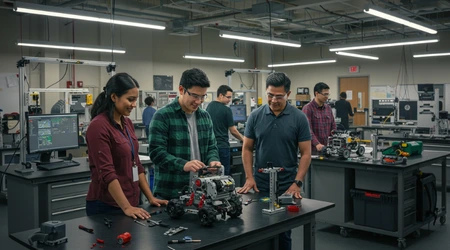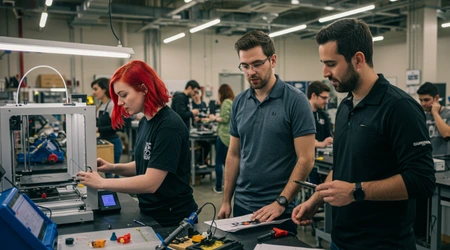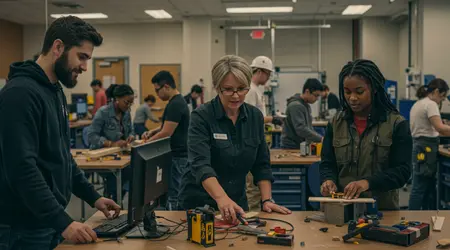The Growing Role of Hands-On Training and Technology Colleges in Canada’s Education Landscape

In 2025, the Growing Role of Hands-On Training and Technology Colleges in Canada reshapes education, addressing workforce demands with practical, tech-driven programs.
As industries evolve, traditional academic paths often fall short in equipping students with job-ready skills.
Enter technology colleges and hands-on training institutions, which bridge this gap by offering specialized, experiential learning.
These schools prioritize real-world application, preparing students for careers in fields like advanced manufacturing, healthcare technology, and cybersecurity.
Unlike conventional universities, they focus on agility, aligning curricula with market needs. This shift is not just a trend it’s a transformation, redefining how Canadians prepare for the future.
Why settle for theory when practice drives progress? This article explores how these institutions are revolutionizing education, their impact on Canada’s workforce, and what makes them essential in today’s dynamic economy.
A Shift Toward Practical Education
Canada’s economy demands skilled professionals, and technology colleges deliver. These institutions emphasize hands-on learning, teaching students to wield tools, code software, or troubleshoot systems.
Programs in welding, robotics, or IT security immerse students in real-world scenarios, fostering problem-solving skills employers crave.
For example, a student at British Columbia Institute of Technology (BCIT) might spend hours in a lab configuring network systems, mirroring actual workplace challenges.
This practical focus contrasts with traditional degrees, which often prioritize theory. Technology colleges adapt swiftly, updating courses to match industry trends like AI or renewable energy.
++ Simon Fraser University Debuts Canada’s First University ‘VTubers’ as Virtual Ambassadors
According to a 2024 Statistics Canada report, 62% of employers prefer candidates with applied training over academic credentials. This statistic underscores the value of experiential learning in today’s job market.
Moreover, these colleges foster adaptability. Students learn to pivot as technologies evolve, a skill critical in fast-changing fields.
By embedding practical experience into education, technology colleges ensure graduates are not just knowledgeable but capable, ready to contribute from day one.

Technology Colleges as Innovation Hubs
The Growing Role of Hands-On Training and Technology Colleges in Canada extends beyond classrooms they’re innovation hubs. Schools like Seneca College integrate cutting-edge tech, such as VR labs, to simulate real-world environments.
A carpentry student, for instance, might use augmented reality to practice building structures, honing skills safely and efficiently.
These institutions also partner with industries to drive innovation. Colleges like NAIT in Alberta collaborate with energy firms to develop sustainable tech programs, ensuring students tackle real industry challenges.
Such partnerships create a feedback loop, aligning education with employer needs while fostering technological advancements.
Also read: Canadian Education Embraces Open Educational Resources (OER) Nationwide
This synergy benefits students and the economy. Graduates enter the workforce with skills honed on the latest tools, while industries gain access to talent ready to innovate. Technology colleges, thus, act as catalysts, fueling Canada’s competitiveness in a global market.
Meeting Workforce Demands
Canada faces a skilled labor shortage, particularly in trades and tech. The Growing Role of Hands-On Training and Technology Colleges in Canada directly addresses this.
Programs in healthcare technology or advanced manufacturing produce graduates who fill critical roles. For example, a medical device technician trained at George Brown College can maintain life-saving equipment, meeting hospital demands.
These colleges also cater to non-traditional students, like career changers. Flexible programs, such as evening classes at Conestoga College, allow workers to upskill without abandoning jobs. This accessibility broadens the talent pool, helping industries stay robust.
Read more: Canada Caps New International Students at 437,000 in 2025: What That Means for Higher Ed
Additionally, technology colleges emphasize micro-credentials short, targeted certifications that address specific skills.
These stackable credentials enable rapid workforce entry, ensuring Canada remains agile in meeting economic demands.
Bridging Equity and Access

Education must be inclusive, and technology colleges excel here. The Growing Role of Hands-On Training and Technology Colleges in Canada promotes equity by offering affordable, accessible programs.
Unlike costly university degrees, these colleges provide shorter, budget-friendly paths to high-demand careers. For instance, a one-year HVAC program at Humber College costs significantly less than a four-year degree, yet leads to stable jobs.
Indigenous communities also benefit. Colleges like Saskatchewan Polytechnic partner with First Nations to offer tailored programs, such as renewable energy training, empowering local economies. These initiatives break barriers, providing opportunities to underserved groups.
By prioritizing accessibility, technology colleges democratize education. They ensure diverse populations, from rural areas to urban centers, can access training that transforms lives and communities.
The Role of Emerging Technologies
The Growing Role of Hands-On Training and Technology Colleges in Canada hinges on embracing emerging technologies. Virtual reality, AI, and IoT are now classroom staples.
At Fanshawe College, students use AI-driven simulators to practice automotive diagnostics, gaining expertise before entering workshops. This tech integration prepares graduates for digital workplaces.
Colleges also teach adaptability to tech disruptions. Courses evolve with trends, like cybersecurity programs addressing quantum computing threats. This forward-thinking approach ensures students stay ahead of the curve.
Moreover, technology enhances learning efficiency. Data analytics, for instance, helps instructors personalize training, identifying student weaknesses early. This fusion of tech and education creates a dynamic, future-ready workforce.
Challenges and Opportunities

Despite their impact, technology colleges face challenges. Funding limitations can restrict program expansion, yet opportunities abound.
The Growing Role of Hands-On Training and Technology Colleges in Canada thrives on innovation. Public-private partnerships, like those at Algonquin College, fund state-of-the-art labs, enhancing training quality.
Another challenge is perception. Some view trades as less prestigious than university degrees, but colleges counter this with success stories.
Graduates like Sarah, a Red River College alumnus now leading a tech startup, showcase the potential of hands-on training.
By addressing these hurdles, colleges can expand their influence. Increased investment and advocacy will solidify their role in shaping Canada’s educational future.
A Collaborative Ecosystem
Technology colleges don’t operate in isolation they’re part of a broader ecosystem. The Growing Role of Hands-On Training and Technology Colleges in Canada relies on collaboration with industries, governments, and communities.
For instance, Mohawk College partners with local tech firms to co-design curricula, ensuring graduates meet specific job requirements.
Government support is also critical. Programs like Canada’s Apprenticeship Grants incentivize hands-on training, boosting enrollment in trades.
These partnerships create a seamless pipeline from education to employment, strengthening the economy.
This collaborative model is like a well-tuned engine: each part colleges, industries, policymakers works in sync to drive progress. Together, they ensure Canada’s workforce remains competitive and innovative.
Data Snapshot: Employment Outcomes
| Program Type | Employment Rate (6 Months Post-Graduation) | Average Starting Salary |
|---|---|---|
| Technology Colleges | 85% | $45,000 |
| Traditional Universities | 78% | $50,000 |
| Apprenticeship Programs | 90% | $40,000 |
Source: Statistics Canada, 2024 Labour Market Outcomes Report
This table highlights the strong employment outcomes of technology college graduates, with apprenticeship programs leading in job placement, reflecting the Growing Role of Hands-On Training and Technology Colleges in Canada.
Conclusion
The Growing Role of Hands-On Training and Technology Colleges in Canada signals a pivotal shift in education.
These institutions empower students with practical skills, bridge workforce gaps, and embrace cutting-edge technologies.
By fostering inclusivity and collaboration, they redefine what education can achieve.
Imagine a student like Jamal, transitioning from a factory job to a cybersecurity expert through a one-year program at Centennial College his story reflects the transformative power of these colleges.
As Canada navigates a tech-driven future, these institutions are not just keeping pace but leading the charge.
Their focus on real-world skills ensures graduates don’t just enter the workforce they shape it. Investing in hands-on training is investing in Canada’s prosperity.
Frequently Asked Questions
What makes technology colleges different from universities?
Technology colleges prioritize hands-on, job-ready skills, with shorter, industry-aligned programs, unlike universities’ focus on theoretical, longer-degree paths.
How do technology colleges support non-traditional students?
They offer flexible schedules, micro-credentials, and affordable programs, enabling career changers and underserved groups to upskill effectively.
Are technology college graduates in demand?
Yes, 85% of graduates find employment within six months, especially in trades and tech, per Statistics Canada’s 2024 report.
How do these colleges use emerging technologies?
They integrate VR, AI, and analytics into training, like using simulators at Fanshawe College for automotive diagnostics, ensuring cutting-edge preparation.
